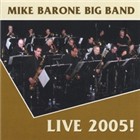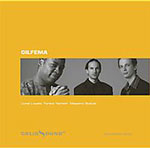Home » Jazz Articles » Swing Set » Glenn Miller: In the Mood
Glenn Miller: In the Mood
 While many people argued whether Goodman or Shaw was the better musician, nobody during the Swing Era could ignore that Glenn Miller left both of them in his wake once he hit the scene. Sure, the bespectacled, tight-lipped bandleader seemed more like the leader of a choir than a swing band, but his keen arranging skills and ear for melody ensured that at least every other tune he recorded seemed like the anthem of the age. He was the most popular bandleader of his day, playing the Glen Island Casino during the summer, the Hotel Pennsylvania's Café Rouge in the autumn and winter, and playing at all times and places through radio broadcasts and Victrolas. To many people, Glenn Miller's music is forever connected with a time and outlook in a way that few of his contemporaries can claim.
While many people argued whether Goodman or Shaw was the better musician, nobody during the Swing Era could ignore that Glenn Miller left both of them in his wake once he hit the scene. Sure, the bespectacled, tight-lipped bandleader seemed more like the leader of a choir than a swing band, but his keen arranging skills and ear for melody ensured that at least every other tune he recorded seemed like the anthem of the age. He was the most popular bandleader of his day, playing the Glen Island Casino during the summer, the Hotel Pennsylvania's Café Rouge in the autumn and winter, and playing at all times and places through radio broadcasts and Victrolas. To many people, Glenn Miller's music is forever connected with a time and outlook in a way that few of his contemporaries can claim.
While many of his songs are classics, with "In the Mood Miller gave the Swing Era its defining moment. With the possible exception of "Sing, Sing, Sing it's the one big band song that everyone seems to know, and generally it's only Miller's original version that gets wide circulation. But it's also one of the best dance songs to emerge from the period, a bouncy fox trot that got the older people on the floor and appeased a younger crowd eager for killer-dillers. There was also the famous fade away section, which never seems to lose its element of suspense upon repeated listenings.
The Sound
 Like other bandleaders Miller was a reluctant star who shied from the spotlight; he once said of personal appearances: "I'm so nervous I'd rather go to jail than make one. His perfectionism as a taskmaster was well known; according to one of his former sidemen, Miller would rehearse every bar of every song a thousand times until he was satisfied. He even insisted on a strict conduct code for the bandstand and on at least one occasion mandated that everyone wear maroon socks. Yet Miller's perfectionism created a tight outfit that featured many of the top arrangers and soloists of the day, many of whom were loyal to him despite the fact that they feared being fired at a moment's notice for unacceptable behavior.
Like other bandleaders Miller was a reluctant star who shied from the spotlight; he once said of personal appearances: "I'm so nervous I'd rather go to jail than make one. His perfectionism as a taskmaster was well known; according to one of his former sidemen, Miller would rehearse every bar of every song a thousand times until he was satisfied. He even insisted on a strict conduct code for the bandstand and on at least one occasion mandated that everyone wear maroon socks. Yet Miller's perfectionism created a tight outfit that featured many of the top arrangers and soloists of the day, many of whom were loyal to him despite the fact that they feared being fired at a moment's notice for unacceptable behavior.
 However, it was Miller's unique and mesmerizing sound that was the linchpin to so many hits. As Gunther Schuller put it, Miller's sound was "able to penetrate our collective awareness in a way that few others have. The basic ingredients were a lead voice composed of the saxophone section and a clarinet (played masterfully by Wilbur Schwartz) juxtaposed with a muted trombone sound wholly separate from the trumpet section. These palettes of color, as it were, gave arrangers a limited spectrum to work with and unified the band's sound to those specific timbres. It was an arranged that ever since then was copied time and time again, a template for what big band music would sound like.
However, it was Miller's unique and mesmerizing sound that was the linchpin to so many hits. As Gunther Schuller put it, Miller's sound was "able to penetrate our collective awareness in a way that few others have. The basic ingredients were a lead voice composed of the saxophone section and a clarinet (played masterfully by Wilbur Schwartz) juxtaposed with a muted trombone sound wholly separate from the trumpet section. These palettes of color, as it were, gave arrangers a limited spectrum to work with and unified the band's sound to those specific timbres. It was an arranged that ever since then was copied time and time again, a template for what big band music would sound like.
"In the Mood"
"In the Mood is based on an old jazz riff that had been passed around for a few years in various forms, most notably in a Fletcher Henderson tune called "Hot and Anxious. Joe Garland created a new arrangement using the riff with the cooler title of "In the Mood. Artie Shaw was the first to dabble with it, but never recorded it because it ran eight minutes, too long for a 78 (however, a live version does exist.) Miller, a gifted editor, was able to pare the tune down to its essentials to fit on one side of a record. "Glenn would get the scissors out and start editing, said Ray McKinley, Miller's former drummer and vocalist. "A cut here, a cut there, do this, do that, and he'd cut it down to the meat and potatoes of the tune. Everyone, of course, is familiar with the meat and potatoes of "In the Mood : the famous introduction featuring the saxophones in unison, the catchy riff that anchors the tune, the suspense building ending; all ingredients of the classic Miller sound.
 "In the Mood has two built in solo sections, including one of the famous "tenor battles between Tex Beneke and Al Klink. Beneke became a star while with the Miller band, playing a smoothed-out version of Coleman Hawkins' style that nevertheless fit perfectly in with Miller's conception. Many felt that Klink could hold his own with Beneke, but Beneke always got the solos, even when arrangers tried to write in parts for Klink. The other is a 16-bar trumpet solo by Clyde Hurley which leads into the famous fade-away ending, which to this day is a model of suspense and dynamics. Miller was able to control the ending to last as long as he wanted, depending on the audience. Many wondered how the band know when to come back in loud; Miller signaled the drummer to hit a cowbell when the band was to come roaring back in.
"In the Mood has two built in solo sections, including one of the famous "tenor battles between Tex Beneke and Al Klink. Beneke became a star while with the Miller band, playing a smoothed-out version of Coleman Hawkins' style that nevertheless fit perfectly in with Miller's conception. Many felt that Klink could hold his own with Beneke, but Beneke always got the solos, even when arrangers tried to write in parts for Klink. The other is a 16-bar trumpet solo by Clyde Hurley which leads into the famous fade-away ending, which to this day is a model of suspense and dynamics. Miller was able to control the ending to last as long as he wanted, depending on the audience. Many wondered how the band know when to come back in loud; Miller signaled the drummer to hit a cowbell when the band was to come roaring back in.
Although "In the Mood made Miller a millionaire, he never collected anything from the proceeds of the sales. He was bound by a no royalty contract, and thus only received $175 for the tune. Later, however, a deal was negotiated whereby Miller's estate was to receive royalties from "In the Mood and other Victor recordings. Miller, of course, was already gone, having vanished overseas in December of 1944 while serving in the military and leading a hugely successful band. He never lived to see the end of the era that he helped shape.
Sources:
Simon, George T. Glenn Miller and His Orchestra. New York: Da Capo Press, 1974.
Schuller, Gunther. The Swing Era New York: Oxford University Press, 1989.
"The Swing Era: 1940-1941. Time Life Records. 1970.
Tags
PREVIOUS / NEXT
Support All About Jazz
 All About Jazz has been a pillar of jazz since 1995, championing it as an art form and, more importantly, supporting the musicians who make it. Our enduring commitment has made "AAJ" one of the most culturally important websites of its kind, read by hundreds of thousands of fans, musicians and industry figures every month.
All About Jazz has been a pillar of jazz since 1995, championing it as an art form and, more importantly, supporting the musicians who make it. Our enduring commitment has made "AAJ" one of the most culturally important websites of its kind, read by hundreds of thousands of fans, musicians and industry figures every month.

























